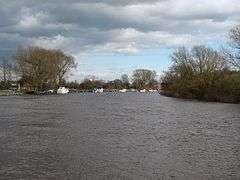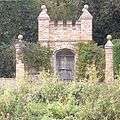Acaster Malbis
Acaster Malbis (/ˈeɪkæstər ˈmælbɪs/) is a village and civil parish in the unitary authority of the City of York, England. It is located on the River Ouse, almost 5 miles (8 km) south of York. Nearby are the villages of Copmanthorpe 2 miles (3.2 km) to the north-west, Bishopthorpe 2 miles to the north and Appleton Roebuck 3.5 miles (6 km) to the south-west. The parish covers an area of about 2,000 acres (8.1 km2).
| Acaster Malbis | |
|---|---|
 The River Ouse at Acaster Malbis | |
 Acaster Malbis Location within North Yorkshire | |
| Population | 669 (2011 Census)[1] |
| OS grid reference | SE587454 |
| • London | 170 mi (270 km) S |
| Unitary authority |
|
| Ceremonial county | |
| Region | |
| Country | England |
| Sovereign state | United Kingdom |
| Post town | YORK |
| Postcode district | YO23 |
| Dialling code | 01904 |
| Police | North Yorkshire |
| Fire | North Yorkshire |
| Ambulance | Yorkshire |
| UK Parliament | |
The Latin word for a camp is 'castra' indicating that the Roman army may once have been based here. The village is mentioned in the Domesday Book as "Acastre". The 'Malbis' is derived from the Norman Malbysse or De Malebys family. Malbis was a Norman personal name that in French means "very swarthy".[2]
There was a Royal Air Force station in the village during and immediately after the Second World War.
According to the 2001 census the parish had a population of 578, increasing to 669 at the 2011 Census.[1] Until 1996 the parish was part of the district of Selby. There are two churches and an inn in the village. The village is also the home for a holiday park.
History
Early history
The land on which the village stands was named by the Romans as Val-Caester. In Latin, Val means "a wall" and Castrum means a "camp".[3] When the Romans departed the land was acquired by an Anglo-Saxon called Aca.[4]
The village is mentioned in the Domesday Book as Acastre in the wapentake of Ainsty and was recorded to belong to two men, Elsi and Robert.[5][6] Ownership passed to the Malbysse family during the reign of Richard I. The family held the lands for about 200 years. In 1190, Richard Malebysse was a leader involved in the massacre of the Jews at Cliffords Tower in York. Richard I dismissed the sheriff and constable of York and imposed severe penalties on the city and arrested many of those who had taken part. Richard Malbysse had been described by a Hebrew scribe eight years earlier as "the evil beast". As punishment, the King ordered his estates seized into the king's hand and two of his esquires were thrown into prison.[7]
In 1314, John De Malbysse was appointed as a Sheriff of the County. His daughter married into the Fairfax family who then inherited the lands after the deaths of John De Malbysse and his son Walter. The Fairfax family held the estates until 1745 when it was sold to Lady Dawes and was eventually inherited by Lord Wenlock.[5]
During the English Civil War, the city of York was under siege from Scottish and Parliamentarian Armies. They had settled around the city in a great arc, with Lord Thomas Fairfax's army to the east and the Scots to the south and west. A bridge of boats, similar to those constructed at Nether Poppleton, was constructed over the River Ouse at Acaster Malbis to allow communications between the two armies.[8]
RAF Acaster Malbis
RAF Acaster Malbis, situated between the villages of Acaster Malbis and Acaster Selby, was commissioned in 1942. Originally it was a grass airfield used by the No 601 Squadron Auxiliary Air Force from 6 January 1942 until April of that year. They flew American Bell P39 Airacobra fighter planes. From 6 April 1942 until the beginning of 1943 No 15 Pilots Advanced Flying Unit was established here to train recently qualified pilots to convert to twin-engine aeroplanes using the Airspeed Oxford aircraft.
On 25 January 1943 the airfield was reconstructed into a full size 'Class A’ bomber station, with three concrete runways, steel hangars and new administration buildings. Initially the airfield was used as a relief landing ground for heavy bombers stationed at Rufforth and Marston Moor. From November 1944, No 4 Aircrew School took over for pilots, navigators, and air gunners to complete their ground training whilst waiting for a posting to a squadron. In 1945 there were between 200 and 300 RAF personnel living on the camp.
After the end of the war, RAF Acaster Malbis was home to No 91 MU (Maintenance Unit) who were responsible for the storage and disposal of vast amounts of ammunition. This function was not complete until well into the 1950s. RAF Acaster Malbis was decommissioned in 1963 and the land sold by public auction. It resumed operations as a private airfield in the mid-1970s until the mid-1980s. Large parts of the runways have since been dug up and the buildings have fallen into disuse with many being demolished, although one hangar and the control tower still remain.[9]
Governance
Acaster Malbis lies in the Bishopthorpe Ward of the Unitary Authority of the City of York. It forms part of the UK Parliamentary Constituency of York Outer and EU Constituency of Yorkshire and the Humber. In 2011 the Ward was won by Councillor John Galvin,[10] a member of the local Conservative Party, after holding the seat in 2015 he again won the seat in 2019, this time as an Independent.
Demography
In 1848 the population of the village was recorded as 322, just under half of the whole population of the parish of the same name.[11] By 1881 this had fallen to 230.[5] According to the 2001 census the parish had a population of 578, which rose to 669 by the time of the 2011 UK Census.[1]
| Population[12][13] | ||||||||||||||||
|---|---|---|---|---|---|---|---|---|---|---|---|---|---|---|---|---|
| Year | 1801 | 1811 | 1821 | 1831 | 1841 | 1851 | 1881 | 1891 | 1901 | 1911 | 1921 | 1931 | 1951 | 1961 | 2001 | 2011 |
| Total | 265 | 286 | 291 | 282 | 322 | 231 | 264 | 243 | 227 | 222 | 225 | 271 | 959 | 271 | 578 | 669 |
Community
There are few amenities in the village save for the 17th-century public house, The Ship Inn. This Inn features in the book, The Girl with the Red Suspenders by Barbara Whitehead.[14] The inn reopened in May 2009 after nine months of major refurbishment, following serious flooding when the River Ouse burst its banks.[15]
The owners of the inn have reported a number of ghostly incidents.[16]
Transport
Harrogate Coach Travel operate a service through the village as part of the York Askham Bar to Tadcaster route.[17]
Education
Acaster Malbis used to have brick built school, founded by John Knowles in 1603.[5][18] As of 2010, primary education is provided at Archbishop of York's CE Junior School[19] in Bishopthorpe.
The village is in the Secondary School catchment area for Fulford School and Millthorpe School in York and also for Tadcaster Grammar School.[20]
Religion
There are two churches in the village. Holy Trinity Church, the Church of England parish church, stands on the site of the original Norman Church. In 1360 the estates of the Malbysse family passed into the hands of the Fairfax family, who pulled the old church down. The church stands a little way out of the village on the road to Bishopthorpe.[5] It is a Grade I listed building.[21]
There is also a Methodist Church in the centre of the village, founded in 1880.[5]
Gallery
2002.jpg) Methodist Church
Methodist Church Holy Trinity Church
Holy Trinity Church The gate folly in Acaster Malbis
The gate folly in Acaster Malbis
References
- UK Census (2011). "Local Area Report – Acaster Malbis Parish (1170211379)". Nomis. Office for National Statistics. Retrieved 3 March 2018.
- "Malbis name". Retrieved 19 November 2010.
- "Roman History". Retrieved 19 November 2010.
- "Anglo-Saxon Owner". Archived from the original on 25 October 2010. Retrieved 19 November 2010.
- Bulmer's Topography, History and Directory (Private and Commercial) of North Yorkshire 1890. S&N Publishing. 1890. pp. 852 & 853. ISBN 1-86150-299-0.
- Open Domesday Online: Acaster Malbis
- "Jewish Massacre in York". Retrieved 19 November 2010.
- "Civil War". Retrieved 19 November 2010.
- "RAF Station". Archived from the original on 3 September 2011. Retrieved 19 November 2010.
- "Ward Councillor". Archived from the original on 9 May 2011. Retrieved 25 October 2010.
- "Population 19th century". Retrieved 19 November 2010.
- "Population at Cenuses". Vision of Britain. 2009. Retrieved 22 March 2013.
- "2001 UK Census". Office for National Statistics. 2002. Retrieved 25 March 2013.
- "Ship Inn". Retrieved 19 November 2010.
- "Ship Inn pub at Acaster Malbis reopens following major refurbishment scheme" yorkpress.co.uk
- The haunted Ship Inn and other ghosts of Acaster Malbis
- "Bus service". Archived from the original on 29 October 2009. Retrieved 19 November 2010.
- "Old School". Retrieved 19 November 2010.
- "Archbishop of York's School". Archived from the original on 16 July 2011. Retrieved 25 October 2010.
- "Guide to School Catchment Areas" (PDF). york.gov.uk. p. 4. Retrieved 5 December 2017.
- Historic England. "CHURCH OF THE HOLY TRINITY (1148450)". National Heritage List for England. Retrieved 25 January 2018.
External links

- Acaster [Malbis] in the Domesday Book